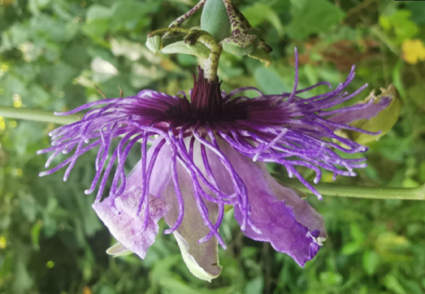Abstract
Two hereto elusive and misunderstood species of Passiflora sect. Simplicifoliae (Passifloraceae), Passiflora guentheri and P. mapiriensis, have been studied and evaluated. This study has shown maintainable differences between the species confirming their taxonomic separation, but questions are raised regarding their origin information and their type localities. From the manuscripts, both species were described as being collected from the exact same locality, which seem unlikely given their close taxonomic alliance. An expedition to Bolivia revisited this location, but also surveyed a wider area to better understand their actual distribution and evaluate the botanical differences between either species. This has shown some consistent botanical traits that warrant their speciation, and examples are given in this paper. Following an extensive planimetric study of the species from this taxonomic group, a third species, here proposed as Passiflora chaskajina sp.nov. is added to the Bolivian flora. The ecology, history, conservation and distribution of the Bolivian members of P. sect. Simplicifoliae has been commented on in this paper.
References
- Arnold, M.L. (1992) Natural hybridization as an evolutionary process. Annual review of Ecology and Systematics 23 (1): 237–261.
- Arnold, P.A., Kruuk, L.E. & Nicotra, A.B. (2019) How to analyse plant phenotypic plasticity in response to a changing climate. New Phytologist 222 (3): 1235–1241. https://doi.org/10.1111/nph.15656
- Cervi, A.C. (2003) Passiflora urubicensis, a new species. Sellowia 10: 53–55. https://doi.org/10.7213/reb.v27i61.21933
- Espinoza, T.E.B. (2014) Two new species of Passiflora subg. Decaloba (Passifloraceae) from Peru and Bolivia. Novon: A Journal for Botanical Nomenclature 23 (3): 263–267. https://doi.org/10.3417/2012066
- ESRI (2023) ArcGIS Desktop: Release 10. Environmental Systems Research Institute, Redlands, CA, USA.
- Feuillet, C. & MacDougal, J.M. (2003 [2004]) A new infrageneric classification of Passiflora L. (Passifloraceae). Passiflora Society Journal 13: 34–38. https://doi.org/10.2307/3393379
- GBIF.org (2023) GBIF Home Page. Available from: https://www.gbif.org (accessed 15 March 2024)
- Harms, H.A.T. (1925) Passifloraceae. Die natürlichen Pflanzenfamilien, Zweite Auflage 21: 503.
- Harms, H.A.T. (1929) Passifloraceae americanae novae. Notizblatt des Botanischen Gartens und Museums zu Berlin-Dahlem 10: 811 pp.
- IUCN (2022) Guidelines for Using the IUCN Red List Categories and Criteria. Version 14. Prepared by the Standards and Petitions Subcommittee. Available from: http://cmsdocs.s3.amazonaws.com/RedListGuidelines.pdf (accessed March 2024)
- Jørgensen, P.M., Cayola, L. & Araujo-Murakami, A. (2010) Passiflora madidiana, a new species of Passifloraceae from northern Bolivia. Novon: A Journal for Botanical Nomenclature 20 (3): 285–288. https://doi.org/10.3417/2009047
- JSTOR (2000-onward) ITHAKA. Available from: https://plants.jstor.org/ (accessed 15 March 2024)
- Killip, E.P. (1938) The American species of Passifloraceae. Field Museum of Natural History, Washington, 408 pp. https://doi.org/10.5962/bhl.title.2269
- Kuethe, J.R. (2020) Passiflora - List of recognized species – 2020. ResearchGate.
- Lemaire, A.C. (1847) Passiflora amabilis. Flore des Serres et des Jardins de l'Europe 3: 1–209.
- Lorenz‐Lemke, A.P., Mäder, G., Muschner, V.C., Stehmann, J.R., Bonatto, S.L., Salzano, F.M. & Freitas, L.B. (2006) Diversity and natural hybridization in a highly endemic species of Petunia (Solanaceae): a molecular and ecological analysis. Molecular ecology 15 (14): 4487–4497. https://doi.org/10.1111/j.1365-294X.2006.03100.x
- MacDougal, J.M. & Espinoza, T.E.B. (2022) Passiflora calicicalyx, a new species in section Decaloba (Passifloraceae) from Bolivia. Novon: A Journal for Botanical Nomenclature 30 (1): 13–17. https://doi.org/10.3417/2022304
- Masters, M.T. (1872) Passifloraceae. In: Martius, K. & Eichler, A. (Ed.) Flora Brasiliensis, vol. 13 (1). Munich, 556 pp.
- Nussey, D.H., Wilson, A.J. & Brommer, J. (2007) The evolutionary ecology of individual phenotypic plasticity in wild populations. Journal of evolutionary biology 20 (3): 831–844. https://doi.org/10.1111/j.1420-9101.2007.01300.x
- Smithsonian (2024) Natural History database. Available from: https://naturalhistory.si.edu/research/botany (accessed 12 February 2024)
- Soltis, P.S. & Soltis, D.E. (2009) The role of hybridization in plant speciation. Annual review of plant biology 60: 561–588. https://doi.org/10.1146/annurev.arplant.043008.092039
- SpeciesLink.net (2020 onward) Centro de referência em informação Ambiental—CRIA. Available from: https://specieslink.net/search/ (accessed 10 March 2024)
- Stevison, L. (2008) Hybridization and gene flow. Nature Education 1 (1): 1–111.
- Thiers, B. (2024-onward) Index Herbariorum. A global directory of public herbaria and associated staff. New York Botanical Garden’s Virtual Herbarium. Available from: http://sweetgum.nybg.org/science/ih (accessed 2 February 2024)
- Tropicos.org (2021-onward) Missouri Botanical Garden. Available from: https://www.tropicos.org/home (accessed 10 March 2024)
- Ulmer, T. & MacDougal, J.M. (2004) Passiflora: Passionflowers of the world. Timber Press, Portland, Cambridge, 430 pp.
- Valladares, F., Gianoli, E. & Gómez, J.M. (2007) Ecological limits to plant phenotypic plasticity. New phytologist 176 (4): 749–763. https://doi.org/10.1111/j.1469-8137.2007.02275.x
- Wawra, H.R.v.F. (1863) Aus dem botanischen garten in Innsbruck. Oesterreichische Botanische Zeitschrift 13: 110
- Westneat, D.F., Wright, J. & Dingemanse, N.J. (2015) The biology hidden inside residual within‐individual phenotypic variation. Biological Reviews 90 (3): 729–743. https://doi.org/10.1111/brv.12131
- Whitney, K.D., Ahern, J.R., Campbell, L.G., Albert, L.P. & King, M.S. (2010) Patterns of hybridization in plants. Perspectives in Plant Ecology, Evolution and Systematics 12 (3): 175–182. https://doi.org/10.1016/j.ppees.2010.02.002


